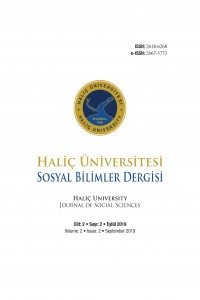Öz
Assuming that the total energy demand is satisfied by oil and
hydroelectric energy, optimal investment in hydroelectric production capacity
which is a function of the size of the dam and the water availability, which
changes by seasons, is analyzed using optimal control theory. Investment cost
in dam capacity depends not only on the purchase cost of additional capacity
but also on the installation of that capacity. The optimal investment is to
invest heavily in early stages by gradually decreasing it until the long-term
equilibrium point is reached. The equilibrium point also oscillates but stable.
However, since the dam size is usually large compared to the amplitude of the
oscillation, the optimal path and the equilibrium level of investment can be considered
to be functions of relevant parameters of the problem only.
Anahtar Kelimeler
Kaynakça
- Amigues, J., Le, K.,and A.A., Chakravorty, U., (2011), Equilibrium Transitions from Non-Renewable Energy to Renewable Energy under Capacity Constraints.Presented at INRA, -Paris and EAERE Rome-2011 conferences.
- André-Garcia F. and Cerda-Tena, E.,(2001), Optimal Substitution of Renewable and Nonrenewable Natural Resources in Production. Working Papers. Serie AD from Instituto Valenciano de Investigaciones Económicas, S.A.
- BP Statistical Review of World Energy (June 2018), 67th edition.:42-43.
- Chakravorty. U., Leach, A., and Moreaux. M., (2009). Twin Peaks in Energy Prices: A Polluting Fossil Fuel with Learning in the Clean Substitute. University of Alberta, Department of Economics in its series Working Papers. 2009-10.
- Chakravorty, U., Leach A., and Moreaux, M., (2010). Would Hotelling Kill the Electric Car? Journal of Environmental Economics and Management, V.61 (3): 281-296.
- Chakravorty, U., Magné, B., and M. Moreaux., (2006). A Hotelling Model with a Ceiling on the Stock of Pollution. Journal of Economic Dynamics and Control, V.30 (12):2875-2904.
- Chakravorty, U., Roumasset, J., and Tse K., (1997). Endogenous Substitution among Energy Resources and Global Warming”, The Journal of Political Economy, V.105 (6): 1201-1234.
- Costello C., Polasky., S., and Solow, A., (2001). Renewable Resource Management with Environmental Prediction, Canadian Journal of Economics, V.34 (1):191-211. Dasgupta, P., and Heal,G. M., (1974). Optimal Depletion of Exhaustible Resources, Review of Economic Studies, V.41 (5):3-28.
- Dasgupta, P., Heal, G. M., (1979). Economic Theory and Exhaustible Resources, Cambridge, Cambridge University Press.
- Dasgupta, P. and Stiglitz, J., (1981). Resource depletion under technological uncertainty, Econometrica, V.49 (1): 85-104.
- E. Moser, Grass, D.,Tragler, G.,and Prskawetz A., (2012). Optimal control models of renewable energy production under fluctuating supply, 12th Viennese Workshop on Optimal Control, Dynamic Games and Nonlinear Dynamics.
- Etner, J., Jeleva, M., and Spaeter, S., (2009).Optimal Decisions on Energy Production with Heterogeneous Risk Perceptions, Paper presented at EGRIE Congress (Toulouse 2008), and AFSE Congress (Paris 2008).
- Førsund, Finn R. (2005) : Hydropower economics, Memorandum, No. 2005,30, University of Oslo, Department of Economics, Oslo.
- Genc, T., and Thille H., (2008).Dynamic Competition in Electricity Markets: Hydropower and Thermal Generation, Presented the Economics of Energy Markets conference, Toulouse, France.
- Greiner, A., Grüne, L., and Semmler, W., (2012).Economic Growth and the Transition from Non-Renewable to Renewable Energy, Available at SSRN: http://ssrn.com/abstract=2098707 or http://dx.doi.org/10.2139/ssrn.2098707,(30 May, 2019).
- Hartley, P.R., Medlock, B. K., Temzelides, T., and Zhang X., (2010). Innovation, Renewable Energy and Macroeconomic Growth, prepared by the The Energy Forum of the James A. Baker Institute for Public Policy. Energy Study paper at Baker Institute. https://www.bakerinstitute.org/research/innovation-renewable-energy-and-macroeconomic-growth/,(30 May 2019).
- Henriet , F., (2012). Optimal Extraction of a Polluting Non-renewable Resource with R&D toward a Clean Backstop Technology, Journal of Public Economic Theory, V.14 (2): 311–347.
- IEA, Electricity Information (2011), International Energy Agency.
- International Energy Outlook (2011), U.S. Energy Information Administration.
- IPCC4 (2007). Climate Change the Physical Science Basis, Cambridge University Press, Cambridge, United Kingdom.
- Kamien, M.I., and Schwartz, N. L., (1991). Dynamic Optimization: The Calculus of variations and Optimal Control in Economics and Management.2nd edition. Amsterdam. Elsevier.
- Maltsoglou, I., (2009).Simulating exogenous and endogenous technology when depletables, renewables and pollution co-exist: how to achieve sustainability? University of Rome ‘Tor Vergata’.
- Marie J. and Amouroux, M., (2004).The economics of hydroelectricity, Hydro 21 Grenoble European Center of Hydropower. Meadows D., (2004).Limits to Growth: The 30-year Update, Chelsea Green Pub.
- Nordhaus, W., (1973).The Allocation of Energy Resources, Brookings Papers on Economic Activity, 3, pp.529-70.
- OECD Economic Outlook 90, 2018.
- OECD Economic Outlook 90, 2011.
- Pontrayagin ,L. S.,Bolyanksii, V. G., Gamkrelidze ,R. V. ,and Mischenko, E .F.,(1962).The Mathematical Theory of Optimal Processes, New York.
- Reichenbach, J., and Requate, T.,(2011).Subsidies for renewable energies in the presence of learning effects and market power, Kiel Working Papers, No. 1689, Schmidt, R. C.,and Marschinski, R. (2009). A Model of Technological Breakthrough in the Renewable Energy Sector, Ecological Economics, V.69 (2): 435-444. Sethi, S.P.2000.Optimal Control Theory Applications to Management Science and economics.2nd ed. Boston: Kluwer.
- Stern, N., (2007). The Economics of Climate Change, Cambridge University Press.
- Stürmer, M., and Schwerhoff, G, (2012).Non-Renewable but Inexhaustible -Resources in an Endogenous Growth Model, Working Paper Series of the Max Planck Institute for Research on Collective Goods.No. 2012-09.
- Tsur, Y.,and Zemel, A., (2009).On the Dynamics of Competing Energy Sources, the Center for Agricultural Economic Research, Discussion Paper No. 15.09, the Hebrew University of Jerusalem.
- Van Der, Swan B.C, and Girlish. R., (2003).Gross World Product and Consumption in A Global Warming Model with Endogenous Technological Change, Resource and Energy Economics, V:25(1):35-57.
- World Bank, (2018), World Bank Data, http://databank.worldbank.org,(30 May 2019).
- World Atlas, (2009), International Journal on Hydropower and Dams.
- TEIAS Publications, http://www.teias.gov.tr/YukTevzi Raporlari.aspx. (May 2012).
Ayrıntılar
| Birincil Dil | İngilizce |
|---|---|
| Bölüm | Makaleler |
| Yazarlar | |
| Yayımlanma Tarihi | 30 Eylül 2019 |
| Yayımlandığı Sayı | Yıl 2019 Cilt: 2 Sayı: 2 |


